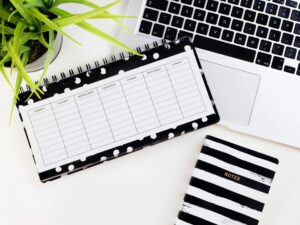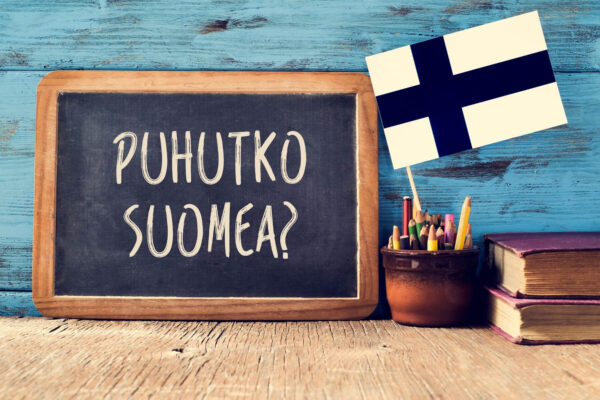Iceland is one of Scandinavia’s most popular holiday destinations. The small island with its breathtaking landscapes attracts numerous travellers every year. So it’s no wonder that more and more people want to learn Icelandic. If you want to get an overview of the Icelandic language and learn your first vocabulary and important phrases, then this beginner’s guide is perfect for you.
Icelandic (íslenska) is a Scandinavian island language from the West Germanic branch of the Germanic language family. It is closely related to Norwegian in particular. Icelandic is the official language of Iceland and is spoken by around 310,000 people today.
| Own designation | íslenska |
|---|---|
| Language origin | Old West Norse |
| Native speakers | approx. 310,000 |
| Official language in | Iceland |
Learn Icelandic – Lesson 1: basic vocabulary and grammar
Basic vocabulary
| Hello! | Halló!/Sæl(l)! |
| Welcome to | Velkominn! |
| Good morning/day/evening/night! | Góðan dag(inn)/ Góða kvöld(ið)/nótt! |
| How are you? | Hvað segirðu gott? |
| I’m doing well. | Mér líður vél. |
| yes | já |
| no | nei |
| Here you go! | Gerðu svo vel! |
| Thank you! | Takk! |
| Excuse me? | Fyrirgefðu, hvað sagðirðu? |
| Excuse me, … | Afsakaðu, … |
| Bye! | Bless! |
The pronouns
| i | ég |
| you | Þú |
| he | hann |
| she | hún |
| it | það |
| we | við |
| you | þið |
| they | þeir/þær/þau |
To introduce oneself
| What is your name? | Hvað heitir þú? |
| My name is … | Ég heiti … |
| Where are you from? | Hvaðan ert ðú? |
| I come from Great Britain. | Ég er frá Bretlandi. |
| I live in … | Ég bý í … |
| I am … years old. | Ég er … árs gamall (m.)/ gömul (f.). |
| I work as a … | Ég vinn sem … |
| And you? | Og Þú? |
Icelandic greetings and small talk: what you should bear in mind
The grammar of the Icelandic language is significantly more complex than that of Swedish and Norwegian, but less complex than that of Finnish. This is already evident in the greeting. For example, the greeting “Good day” – “Goðan dag!” is answered with the specific form “Goðan daginn!”.
For small talk in general, the weather is a very popular topic for everyday conversation. This has arisen from a combination of different cultural factors: the North Atlantic island is not only affected by rapid and violent changes in the weather, but was (and to some extent still is) dependent on the weather due to its focus on agriculture.

Did you know? The Icelanders are so-called language purists. This means that they attach great importance to their language as a cultural medium and therefore reject loan words. The Icelandic Language Commission therefore meets regularly to find new Icelandic words for loanwords. For example, the computer is called “tölva” in Icelandic, a term made up of the words “tala” for “number” and “völva” for “fortune teller”.
The greeting and farewell
The short form of the colloquial greeting in Icelandic is Sæl or Sæll, depending on whether you use the masculine or feminine form or whether you use the singular or plural. This comes from the old formula “Blessaður og sæl/! Blessuð og sæll!”, which means something like “Be blessed and happy”. This is also where the abbreviation “Bless!” comes from when saying goodbye.
Basic grammar rules: what you should know
- Capitalisation: In Icelandic, only the first letter at the beginning of a sentence is capitalised. An exception are the beginnings of sentences after direct speech; these are written in lower case.
- Sentence order: Icelandic follows the subject – verb – object pattern. This is very similar to simple English sentences.
- Gender and articles: In Icelandic, three grammatical genders or genera are used: Masculine, Feminine and Neuter. The gender can usually be recognised by the ending of the word. In most cases, -ur indicates a masculine gender, -a, -in and -un indicate a feminine gender and a missing ending or a vowel with an accent indicates a neuter gender.
- Declension of nouns: In contrast to Swedish or English, nouns in Icelandic must be declined according to cases, just as in German. The form a noun takes depends on the gender, number and case.
- Inflection of adjectives: Adjectives are also inflected in Icelandic and are adapted to the noun to which they refer.
- Conjugation and tenses: Verbs are also conjugated in Icelandic. However, many of the most important ones such as “to be” – “vera” are irregular and have to be learnt by heart. Overall, however, most verbs follow a pattern.
Vocabulary trainer: Basic vocabulary



Learn Icelandic – Lesson 2: how to find your way around on holiday
On holiday
| On holiday | Í fríi |
| Airport | flugvöllur |
| Hand luggage | handfarrangur |
| Suitcase | ferðataska |
| Rucksack | bakpoki |
| Cash dispenser | hraðbanki |
| book | (að) bóka |
| Passport | vegabréf |
| Hotel | hótel |
| Reception | gestamóttaka |
| Floor / storey | hæð |
| Room service | herbergisÞjónusta |
| Holiday home | frístundahús |
| Old Town | gamall bæjarhluti |
| Bicycle | hjól |
| Train | lest |
| Ticket | farmiði |
| Travel guide | ferðahandbók |
| City map | borgarkort |
| Museum | safn |
| to do something | (að) aðhafast |
| hike | (að) ganga |
| camp | (að) tjalda |
| to swim | (að) synda |
Emergency
| Emergency | bráðatifelli |
| Emergency call | neyðarlína |
| Help! | Hjálp! |
| Hospital | spítali |
| Pharmacy | apoték |
| Doctor | læknir |
Icelandic pronunciation: what you need to know
Icelandic pronunciation differs from the other Scandinavian languages in many areas. This is partly due to the many letters and accents that do not exist in English and often in other Scandinavian languages. In addition, many letter combinations are pronounced differently. For example, an ll is often pronounced like a dl. Overall, however, it can be said that most people quickly get used to the pronunciation of the most important sounds in Icelandic. The finer points come later.
How do you pronounce þ and ð?
The þ, also known as thorn, and the ð are letters that puzzle many people. They come from Old English and Old Norse, but are only used in this spelling in a few languages today. In terms of pronunciation, however, they can still be modelled on English. Both the þ and the ð are pronounced similarly to the English th.
The difference lies in the voicing of the pronunciation. This means that while the ð is pronounced like the th in the English “mother”, the þ sounds more like the th in the English “three”. The ð is therefore softer and the vocal chords vibrate. This is not the case with the þ.
Vocabulary trainer: On holiday



Order and shop
| order | (að) panta |
| Restaurant | veitingastaður |
| Café | kaffihús |
| I would like to have … | Ég ætla að fá … |
| Enjoy your meal! | Verði Þér að góðu! |
| Cheers! | Skál! |
| Breakfast | morgunmatur |
| Lunch | hádegismatur |
| Dinner | kvöldmatur |
| This is very tasty. | Þetta bragðast vel! |
| Can I have the bill, please? | Gæti ég fengið reikniginn? |
| May I pay, please. | Má ég borga takk. |
| That’s right. | Eigðu afganginn! |
| go shopping | (að) fara út í búð |
| Shop / shop | búð |
| Supermarket | stórmarkaður |
| Fruit and vegetables | ávextir og grænmeti |
| Dairy products | mjólkurafurðir |
| Meat | kjöt |
| Fish | fisk |
| Bread | brew |
| Water | vatn |
| Coffee | kaffi |
| Beer | öl |
| Wine | vín |
| (Icelandic) alcohol trade | vínbúðin |
| Clothing shop | farabúð |
| Cash register | kassi |
| Bag | poki |
| Where can I find … ? | Hvar finn ég …? |
| How much does it cost? | Hvað kostar Þetta? |
Orientation
| Orientation | kynheigð |
| Entrance | anddyri |
| Exit | útgangur |
| Toilet | klósett |
| Tourist information | upplýsingar fyrir ferðafólk |
| Railway station | lestarstöð |
| Bus stop | strætóstoppistöð |
| Post office | pósti |
| Street | gata |
| Petrol station | bensínstöð |
| Exit | útakstur |
| Car park | bílastæði |
| Crossroads | gatnamót |
| Motorway | hraðbraut |
| Roundabout | hringtorg |
| Bridge | brú |
| Excuse me, I have a question. | Afsakið, ég er með spurningu |
| Where can I find … ? | Hvar finn ég …? |
| Where is … ? | Hvaðan er …? |
| I am looking for … | Ég er að leita að … |
| How do I get there? | Hverning kemst ég Þangað? |
| How far is it to … ? | Hve langt er til …? |
| I have lost my way. | Ég er týnd(ur). |
| You have to turn right/left. | Beygðu til hægri/vinstri. |
| Go straight ahead. | Gjörðu svo vel. |
| behind | að baki |
| beside | hjá |
Learn Icelandic pronunciation: the most important rules for beginners
- The þ is pronounced roughly like the th in “three”, while the ð sounds like the th in “mother”.
- As in other Scandinavian languages, the correct r is important. It does take some practice, but don’t let that put you off. To pronounce the Icelandic r, try rolling your tongue backwards.
- Many people pronounce the æ like a German ä at first glance – so like the a in the English word “bad”. However, this is not correct. Instead, it is pronounced like an ei in the word “I”.
- The accent also changes the pronunciation of letters. The á undergoes the greatest change, as it is pronounced like the ou in “mouse”.
- With í, on the other hand, only the length changes. Although there are exceptions, the general rule is that the i is pronounced long and the í short. This also applies to y and ý. These letters are pronounced exactly like y and ý.
- The ó is pronounced like “home” in English. While the u is pronounced more like an ü, the ú is pronounced like the normal u.
- The ll is pronounced more like a dl in Icelandic. This is especially true at the end of words and often takes some getting used to for non native speakers.
- Interrogative words in particular often begin with hv. This combination is pronounced like kv.
- An f before an l is pronounced as a p. This means that the famous Icelandic airport Keflavik near Reykjavík is pronounced like “Keplavik”.
Vocabulary trainer: On the road



Learn Icelandic – Lesson 3: more everyday vocabulary
Weather
| Weather | veður |
| Weather forecast | veðurspá |
| Temperature | hiti |
| Degree | stig |
| Sun, sunny | sól, sólbjartur |
| blue sky | blár himinn |
| Rain, rainy | rigning, rigningasamur |
| Wind, windy | vindur, vindasamur |
| Snow | snjór |
| Ice, icy | ís, ísilagður |
| Frost | frost |
| Hail | hagl |
| Fog, foggy | Þoka, Þokufullur |
| Clouds, overcast | ský, skýjaður |
| Storm | stormur |
| Thunderstorm | Þrumuveður |
| Lightning | elding |
| Thunder | Þruma |
| wet | blautur |
| moist | rakur |
| dry | Þurr |
| smooth | háll |
| warm | hlýtt |
| cold | kaldur |
| Season | árstíð |
| Spring | vor |
| Summer | sumar |
| Autumn | haust |
| Winter | vetur |
The Icelandic language melody
The stress in Icelandic is on the first syllable. The pronunciation of long vowels and diphthongs, i.e. several consecutive vowels, also takes some getting used to. In addition, many of the plosives, i.e. p, t and k, are pronounced voiceless. This also applies to the s. Overall, it is important when learning Icelandic that you work with audio examples or a teacher so that you learn the pronunciation.

Numbers (up to 10)
| one | einn |
| two | tveir |
| three | Þrír |
| four | fjórir |
| five | fimm |
| six | sex |
| seven | sjö |
| eight | átta |
| nine | níu |
| ten | tíu |
Weekdays
| Weekday | vikudagur |
| Monday | mánudagur |
| Tuesday | Þriðjudagur |
| Wednesday | miðvikudagur |
| Thursday | fimmtudagur |
| Friday | föstudagur |
| Saturday | laugardagur |
| Sunday | sunnudagur |
Learn Icelandic pronunciation: 3 tips
- Learn pronunciation directly: Especially in Icelandic, where pronunciation is often tricky, you should definitely learn with a source that also provides you with audio examples. A language course with a native speaker teacher is ideal.
- Repeat and record: Especially when you are learning your first vocabulary and phrases, it is important to get used to Icelandic pronunciation. Texts that are read aloud on an audio file accompanying the book, for example, are perfect. Listen to the recording and repeat it. Record yourself and compare the two recordings. This way you can immediately hear what you still need to work on.
- Feedback from native speakers: It’s very important that you speak the language when you’re learning Icelandic. A language course is also particularly suitable here, as dialogues can be practised directly.
Vocabulary trainer: Weather, numbers, days



FAQ: Why learn Icelandic?
Icelandic is a language that is not easy to learn. This is not only due to the challenging pronunciation, but also to the complex grammar. Nouns, adjectives and verbs have to be inflected and harmonised according to learned patterns, comparable to English. The complexity is greater than in Swedish and Norwegian, but less than in Finnish.
Icelandic and Norwegian are related to each other. If you are not yet sure which of the two languages you would like to learn, you should consider the following factors: Norwegian has two written variants with different levels of grammar complexity and consists of different dialects. There is therefore no “High Norwegian” in the spoken language. Icelandic is different, but the grammar is somewhat more complex. It is advisable to listen to both languages and get an overview of the grammar before making a decision. As Icelandic and Norwegian are related, it is not a problem to switch after a while.
Learn Icelandic in depth
If you want to learn Icelandic in depth, we recommend taking a language course in the long term. If none are available locally, online courses are also recommended.
Learn Icelandic with apps
For many people, the smartphone is a daily companion these days. So it’s a good thing that apps can also help you learn Icelandic. However, as Icelandic is a rather small language, the choice is unfortunately limited. We recommend the Drops app, which advertises that you can learn Icelandic in just five minutes a day. We think that the app is a good addition, but that a language course and accompanying books or audio courses form the basis for successfully learning Icelandic.
Books, audio books & audio language courses
Books are helpful for many beginners to learn vocabulary and inflection paradigms. Reading texts at your own pace is also often helpful. A combination of books and audio courses is also a good way to learn pronunciation.
If you are more of an auditory learner, you can of course also take an audio language course. Audible, for example, offers a selection here. The practical thing about this is that it’s easy to do on the go or on the side. It can also help you learn pronunciation, especially in Icelandic.
Learn more Scandinavian languages
Are you interested in other Scandinavian languages? Then take a look at our guides to learning Swedish, learning Norwegian and learning Danish. This will give you an easy overview before you decide whether you want to learn the language.



